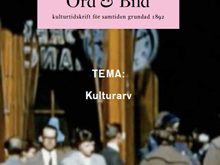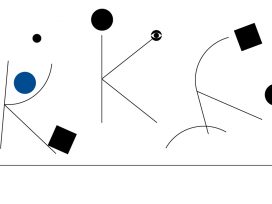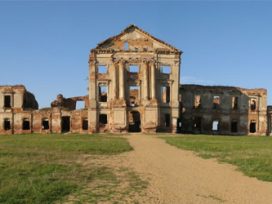Ever since 1999, when they began to hold major international exhibitions in parallel with the national pavilions, there have been ceaseless discussions about the inability of the latest new curator of the Venice Biennale to fill the shoes of the initiator of the tradition, Harald Szeemann. Furthermore, our memory mercilessly reminds us that each successive incumbent has seemed weaker than his or her predecessor. But the magnetic attraction of the Biennale remains the same as ever, and the curator’s exhibition is still the centre of intrigue.
It is true that Szeemann’s exhibitions (1999 and 2001) coincided with the first occasions that Latvia participated in Venice when, for those of us who were among the first to visit, everything about the Biennale seemed so wondercful, rich and unfathomable. The Arsenale, then only recently reclaimed itself, was an attraction in its own right with surprises everywhere we turned. Take for example the impressive Chinese drum kit and its resounding musical performance combined with the installations by Chinese artists and their stories about resistance to the regime and talented émigrés – which could later be viewed in the all the major European exhibition halls. This attitude remains, and the Arsenale continues to welcome the unexpected, the refreshing and the grandiose. The public can focus on subtler things at the Palazzo delle Esposizioni at the Giardini. Here one could discover Matthew Barney’s delicate installations or the tragic watercolours of Marlene Dumas. The curator exhibitions are interesting because they allow us both to see familiar names from new angles and to discover the unknowns.
So how were things this time?
Despite the promises of surprises and new works created especially for the Biennale, Bice Curiger’s exhibition ILLUMInations is based on so-called traditional values, i.e. works by well-known Swiss, German, British and American artists that have already been exhibited in galleries and museums, with the centre and point of reference being three paintings by Tintoretto specially delivered to the Biennale from their home at the Accademia and the Basilica San Giorgio Maggiore. “In the work of many contemporary artists (the ones who interest me the most), I find the same search for light, both rational and febrile, that animates some of Tintoretto’s later works. Tintoretto too was worried about overturning the conventions of his time, through a near reckless approach to composition that overturns the well-defined, classical order of the Renaissance. I am interested in the light in those paintings, which is not rational but ecstatic,” states Curiger.
The reference to light and the illumination of the identity of nations; the classic Tintoretto as an unprecedented element of the great contemporary show; “pictorial energy” combining works by classical and contemporary artists; and “five questions about identity” which should help establish the “contemporary collective mental landscape” – all these formulations are there to assist us in unravelling the overall rationale behind the 83 works in the exhibition. The descriptions by Bice Curiger (who is both a well-trained theorist as well as a practitioner) of what’s on show in the Biennale catalogue seem convincing and compelling. Yet the viewer passes through the exhibition led by own thoughts and feelings, stopping by the works that attract their attention. And only afterwards (perhaps) takes an interest in what they were supposed to see there.
Well, OK, light and illumination are powerful enough reference points to keep in mind and put to use. In the case of “Artificial Peace” by Latvia’s Kristaps Gelzis, this was a concept accomplished in the national pavilion with stunning results. However, already after the first steps in the international exhibition in the Giardini, the curator’s concept has been forgotten. The exhibition in the Palazzo delle Esposizioni is demonstratively heralded by an unobtrusive light bulb-object (by American artist Sturtevant) above the entrance leading to the central hall housing the Tintoretto works. But it’s the hall with the Tintorettos where we encounter the first disappointment. The three paintings by the temperamental Venetian placed on three separate walls in the big, white, darkened space seem to dissolve. I find myself thinking that however much I may appreciate the uniqueness of this moment and cherish the treasures of classical art, these paintings and the message they convey would be much easier to appreciate in a traditional museum, let alone an authentic church environment. And even though I theoretically understand the possible connotations of “illumination”, they fail to provide a bridge to the rest of the exhibition.
The works that follow are autonomous, normal exhibition components, lacking a unifying script that would lead to “ecstatic” light. The curator’s explanations to the effect that one of the artists (Christopher Wool, for example) has studied, say, a brush stroke by Tintoretto and used this as the basis for one of his large-format works, do not in themselves create a flow of “pictorial energy” (at least in my perception). A more attractive note is provided by a room with graphic decorative suns enlivened by coloured light filters (DAS INSTITUT and Kerstin Brätsch). Maurizio Cattelan’s 2000 pigeons, already seen in the 1997 Biennale as Tourists, are perched on the pavilion’s beams. Yes, Sigmar Polke’s works, which hide their imagery in a sort of corrugated surface, on this occasion emphatically point to a play with light and even include an appropriate fragment from an eighteenth century print.
The video projections by Pipilotti Rist which “light up” the Venice sky with scenes from contemporary life are also a continuation of the visual surprises provided at several successive biennales. The space with strictly geometrical modelled objects with a lunar form glowing in the corner (Fischli & Weiss) seemed like the most intriguing combination simply but impressively preserving the flavour of innocent, elementary secrets. A room with a red plasticine mountain in the middle had been deliberately designed for the audience to enjoy and play with (and so they did, with great enthusiasm). Again Cindy Sherman wallpapers the room with depictions of the various roles of women but this time in a new, monumental format. “Hippy Dialectic” by Nathaniel Mellors was a joy, of course, with its two arguing but conjoined heads forming a mobile and witty object supplemented by a pair of films devoted to these two weirdoes.
The so-called parapavilions are spoken of as the innovation of this biennale. One artist provides the space, the other places their own works in it. A challenging concept for the viewer to fully comprehend and assess, moreover the arrangement is not always mutually successful. In my opinion, the interplay between the parapavilion by Polish artist Monika Sosnowska, created in the shape of a star, and South African photographer David Goldblatt’s photographed portraits – criminals of various categories at the scenes of their crimes – was one that worked. Psychologically powerful portraits squeezed into sloping plane passages. It was undoubtedly also the most classical of the collaborations. In one of the Arsenale halls, attention was drawn to a building created from door lattices typical of warmer climates – it turned out that it was a building by Chinese installation artist Song Dong, a real building, brought to Venice as a parapavilion. But any interest in examining whether it had been supplemented by another artist’s works and what they were dissipated because the object was sufficient in itself.
On entering the Arsenale, the first halls capture one’s attention with decoratively powerful lighting arrangements such as glittering beads in a changing pattern which, possibly, has as its basis a complex philosophical / intellectual concept. And further on – as is usually the case – there are many different types of art that to a greater or lesser degree attract attention. At least two objects succeed unerringly in doing this: Swiss artist Urs Fischer’s melting wax candle replicas of antique art (Giambologna’s “Rape of the Sabine Women”), its researcher (perhaps the museum director) and an office chair – a trinity which possibly symbolizes the transient glory of classical culture. But perhaps they remind us of themselves as the only light – as candles in the dark? The title of the work is, of course, “Untitled”. Although it’s impressive, it’s hard to fight off reminiscences of works by Flemish artist Jan Fabre that are almost wed to Venice, and which always appear in new spaces during the biennale – this time in the Scuola Grande di Santa Maria della Misericordia, and they definitely also incorporate the figure of the artist himself.
The second object is a cinema theatre fitted with comfortable chairs, where the installation “The Clock” by Swiss Christian Marclay is on show. This is in fact a witty montage of film stills of various ages and origin, showing certain times on the clock following the whole 24 hour cycle. Whoever was able to devote a full viewing period to it was guaranteed a treat. This is the work that was awarded the main prize in the Biennale. Without denying the painstaking montage and imagining those kilometres of film that had to be viewed in order to select what was needed, the feeling still remains that the jury’s assessment may have been skewed more towards pleasant entertainment. Comfortable enjoyment, Swiss style.
I feel as I write that the scene seems more interesting than it appeared in the reality of the exhibition. Perhaps the problem was in the uniformity and correctness with which the display was created? It contained no surprises. Perhaps it is specifically the profoundness of the concept and the attempt to realize it at any cost, within one’s familiar comfort zone, that often “kills” the potential live nerve in the end result?
“Structured chaos” was how Szeemann described his method of creating exhibitions. It really was fertile, and the novelty that he came onto the scene with was the large exhibitions with the concept of a unifying theme, offering diversity and possibilities for unexpected comparisons within the framework of a single show. This approach has now become the norm in the practice of presenting exhibitions, only now it seems that the “chaos” has become more flat and obvious without offering any great hope of digging out surprises from the “depths of the jungle”. The intensive process of discovering the contemporary contributions from exotic lands, which began with Szeeman and which Francesco Bonami also superbly continued with his 11 co-curator programme in the 2003 Biennale, has resulted in a conspicuous growth in the number of “national pavilions”: this year there are 89 of them, mainly newcomers from Asia, Africa and South America. This year Argentina, the first of the Latin American countries to take part in the Venice Biennale (since 1902), formally signed an agreement on a permanent pavilion in the Arsenale area. And it was this year, specifically, that Argentina couldn’t be ignored: a magnificent clay sculpture composition in brutalist manner with the provocative title “The Murderer of Your Heritage” by Adrian Villár Rojas made you stop with the truly suggestive power of its sculptural mass creating a real monster forest – the invisible materialized but existing in another dimension, a visionary world with demons gathered together from various universes. It really is a miracle that anyone still works in this way: purely sculpturally, voluminously, with huge masses of material, which moreover is new and contemporary.
Without a doubt, each new curator now works much more rationally on the concept for the major exhibition as it is becoming far more difficult to find surprises in an objective view from the sidelines. National pavilion curators are more likely to be able to supply these because they know their territory from the inside. It is also clear that, for their own exhibition, each nominated curator highlights and pulls out “favourites” – for Robert Storr it was a high proportion of American art, and for Curiger this year it was the palpable presence of the Swiss, which also impacted on the central exhibition events. But the difficulty of finding the interesting, the captivating is becoming increasingly evident especially if one concentrates on Central European art – which is what Curiger, associated with Switzerland and the Tate Gallery, was doing. The previous Biennale, curated by the popular theoretician and Moderna Museet director Daniel Birmbaum, had already demonstrated this.
Hence, a serious question that should have been asked a long time ago is why Eastern Europe, with a few and not always successful exceptions, stubbornly continue to remain outside the zone of serious investigation? Perhaps this is the impression that has been created by the national pavilions of these countries up till now? It is not always possible to objectively generalize them. Maybe choosing a curator from a region further east would introduce something new? Rushing about through Eastern Europe and the Baltic region for a couple of days can only give a rational Western European curator a vague notion about what’s happening there, let alone find something “really special”. But for us to hold out any particular hopes may be a little premature – the exchange of information in our corner of the world is also rather slow-moving. The magazine Studija in two languages and the new arterritory.com website which promises to embrace current art processes not only in the Baltic but also in Scandinavia, as well as the creation of an international panel of judges for the Purvitis Prize, is the way towards a full-blooded exchange of information. But this has only just begun.






